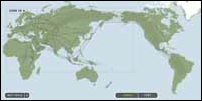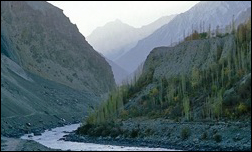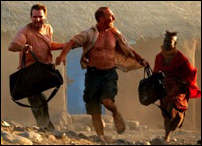I recently did an e-mail interview with the good folks at the [Wisconsin Screenwriters Forum](http://www.wiscreenwritersforum.org/), only to realize that a significant percentage of my readership base (aspiring screenwriters, [confused Christians](http://johnaugust.com/archives/2005/liam-found-a-mistake-in-the-bible), web-surfing office drones) lives outside of our 30th state, and therefore might not receive the newsletter.
So with WSF’s kind permission, I’m reprinting it here.
Could you tell me a little about the process you went through from the time you decided you wanted to write screenplays, to the time you wrote GO?
I wrote my first script in graduate school. It was a romantic tragedy set in Colorado. Reading it now, I don’t think it’s all that good, but the writing showed enough promise to get me some meetings, and ultimately an agent. By that time, I had already written the first part of Go, designed to be a short film. It was only several scripts later (after How to Eat Fried Worms and A Wrinkle in Time) that I went back and wrote the full version of Go.
I pretty much always wanted to be a writer, but I didn’t really know anything about screenwriting until I got to Los Angeles. Like all new screenwriters, it took a while to get used to the format.
How did GO make its way from an idea in your mind to your first produced feature film?
Go came from a bunch of little incidents I’d collected over the years, some true, some not. A lot of people focus on the structure of it, but I think what makes it work is that moment-by-moment, you’re not sure where the hell it’s going. That’s very much the experience of being twenty.
What process do you adhere to, if any, when approaching an adaptation?
Adaptations are really no different than originals. You’re looking for what’s inherently the “movie idea.” Sometimes that’s obvious (Jurassic Park) and sometimes that’s more work to uncover (Big Fish). But in both cases, you’re best off building the movie from the ground up, rather than trying to force the original material into a cinematic shape.
What are some of the smartest things you’ve done in regards to your career? Things you feel have helped bring you to your current level of success.
I was never a big networker. I didn’t keep up relationships on the off chance that someday I’d work with a certain person. But I learned how to be good in meetings, which means knowing when to talk and when to listen. When people would give me stupid notes, I wouldn’t reject them outright, but would rather try to intuit what they actually wanted, even if they couldn’t articulate it. And I’ve always tried to be the guy who comes up with solutions, rather than pointing out problems.
Have you made any mistakes along the way, in regards to your screenwriting career, which others could potentially learn from?
Especially early in my career, I’d fall in love with a given scene and do anything to keep it in the script, even if in my heart I knew it wasn’t working for the story. Now, I’m a lot more ruthless. There will always be other great scenes. What’s important is that the piece as a whole is working.
How do you approach writing that snappy dialogue you’ve become popular for?
Dialogue is just the way people would talk if they had a few extra seconds to think about what they were going to say. It’s not exactly natural; it’s more compressed and streamlined. I think it’s a lot like how illustrators do animation, flipping pages back and forth to see how it moves. I’m constantly reading from line to line, making sure the rhythm works.
What are some of your favorite movies? Screenplays? Books?
My favorite movie is Aliens, which is probably my favorite screenplay as well. I don’t know that I have one favorite book. I don’t tend to re-read books the way I’ll re-watch movies, so I don’t have the same kind of familiarity with any one work. But in general, I love the dysfunctional family genre, such as Augusten Burrough’s RUNNING WITH SCISSORS or David Sedaris’ NAKED.
What piece of advice could you have used back when you were an aspiring screenwriter?
To worry less about the format and more about the words. Honestly, if a script has terrific writing, no one will give a rat’s ass about the margins and sluglines. There’s far too much emphasis on doing things right, and not enough on doing things brilliantly. When you read a great script, the paper disappears and you feel like you’re watching a movie. That has nothing to do with 12 pt. Courier. It’s artful writing, and that’s the only crucial element
 Dear John,
Dear John, I wish I could say that I was completely calm and sensitive, but mostly I kept barking at her not to play with it and not to lean back into her car seat, and that I would take care of it when we got home. She whined and cried the whole way (one of the terrible things of being a parent that make you wish that those _gumball gift_ moments came more often).
I wish I could say that I was completely calm and sensitive, but mostly I kept barking at her not to play with it and not to lean back into her car seat, and that I would take care of it when we got home. She whined and cried the whole way (one of the terrible things of being a parent that make you wish that those _gumball gift_ moments came more often).  My last normal job — the 9-to-5 kind — was as an assistant at [Oliver Stone’s](http://imdb.com/name/nm0000231/) production company. At the time, he was in post-production on [Natural Born Killers](http://imdb.com/title/tt0110632/), and developing future projects, one of which was a remake of Planet of the Apes.
My last normal job — the 9-to-5 kind — was as an assistant at [Oliver Stone’s](http://imdb.com/name/nm0000231/) production company. At the time, he was in post-production on [Natural Born Killers](http://imdb.com/title/tt0110632/), and developing future projects, one of which was a remake of Planet of the Apes. For instance, my ancestors travelled through the Pamir Knot, which I’d never heard of. But looking at the picture, you realize that somewhere back in history, some relative lived there. Hunted there. Died there. It was 40,000 years ago, but it’s still in my blood.
For instance, my ancestors travelled through the Pamir Knot, which I’d never heard of. But looking at the picture, you realize that somewhere back in history, some relative lived there. Hunted there. Died there. It was 40,000 years ago, but it’s still in my blood.